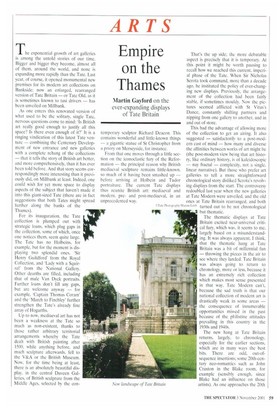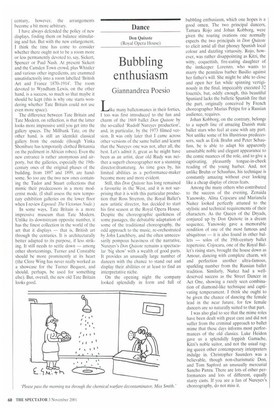Empire on the Thames
Martin Gayford on the ever-expanding displays of Tate Britain
The exponential growth of art galleries is among the untold stories of our time. Bigger and bigger they become, almost all of them. around the world, and none is expanding more rapidly than the Tate. Last year, of course, it opened monumental new premises for its modern art collections on Bankside: now an enlarged, rearranged version of Tate Britain — or Tate Old, as it is sometimes known to taxi drivers — has been unveiled on Millbank.
As one enters this renovated version of what used to be the solitary, single Tate, nervous questions come to mind: 'Is British art really good enough to justify all this space? Is there even enough of it?' It is a ringingvindication of this latest Tate venture — combining the Centenary Development of new entrance and new galleries with a complete rehang of the collections — that it tells the story of British art better, and more comprehensively, than it has ever been told before. And that story seems correspondingly more interesting than it previously did, on Millbank at least. Indeed, one could wish for yet more space to display aspects of the subject that haven't made it into this giant-sized Tate (there are in fact suggestions that both Tates might spread further along the banks of the Thames).
For its inauguration, the Tate collection is plumped out with strategic loans, which plug gaps in the collection, some of which, once one notices them, seem quite large. The Tate has no Holbeins, for example, but for the moment is displaying two splendid ones. 'Sir Henry Guildford' from the Royal Collection, and 'Lady with a Squirrel' from the National Gallery. Other dearths are filled, including that of male Van Dyck portraits. Further loans don't fill any gaps, but are welcome anyway — for example, 'Captain Thomas Coram' and the 'March to Finchley' further strengthen the Tate's already fine array of Hogarths.
Up to now, mediaeval art has not been a weakness at the Tate so much as non-existent, thanks to those rather arbitrary territorial arrangements whereby the Tate dealt with British painting after 1500, while anything before, and much sculpture afterwards, fell to the V&A or the British Museum. Now, for the time being at least, there is an absolutely beautiful display, in the central Duveen Galleries, of British sculpture from the Middle Ages, selected by the con temporary sculptor Richard Deacon. This contains wonderful and little-known things — a gigantic statue of St Christopher from a priory on Merseyside, for instance.
From that one moves through a little section on the iconoclastic fury of the Reformation — the principal reason why British mediaeval sculpture remains little-known. so much of it having been smashed up — before arriving at Holbein and Tudor portraiture. The current Tate displays thus reunite British art: mediaeval and modern. preand post-mediaeval, in an unprecedented way. That's the up side; the more debatable aspect is precisely that it is temporary. At this point it might be worth pausing to recall how we reached this current. imperial phase of the Tate. When Sir Nicholas Scrota took command, more than a decade ago. he instituted the policy of ever-changing new displays. Previously, the arrangement of the collection had been fairly stable, if sometimes mouldy. Now the pictures seemed afflicted with St Vitus's Dance, constantly shifting partners and nipping from one gallery to another, and in and out of store.
This had the advantage of allowing more of the collection to get an airing. It also suggested — satisfactorily to a post-modern cast of mind — how many and diverse the affinities between works of art might be (the post-modern view being that art history, like ordinary history, is of kaleidoscopic — nay fractal — complexity, not a single, linear narrative). But those who prefer art galleries to tell a more straightforward chronological story disliked Scrota's revolving displays from the start. The controversy redoubled last year when the new galleries at Tate Modern were unveiled, and the old ones at Tate Britain rearranged, and both arcus Lcith turned out to be not chronological but thematic.
The thematic displays at Tate Britain excited near-universal critical fury, which was, it seems to me, largely based on a misunderstanding. It was always apparent, I think. that the thematic hang at Tate Britain was a bit of millennial fun — throwing the pieces in the air to see where they landed. Tate Britain was always going to return to chronology, more or less, because it has an extremely rich collection which makes most sense presented in that way. Tate Modern can't, because the sad truth is that our national collection of modern art is drastically weak in some areas — the consequence of innumerable opportunities missed in the past because of the philistine attitudes prevailing in this country in the 1930s and 1940s.
The new hang at Tate Britain returns, largely, to chronology, especially for the earlier sections, which are in many ways the best bits. There are odd, out-ofsequence insertions; some 20th-century neo-romantics such as John Craxton in the Blake room, for example (sensibly enough, since Blake had an influence on those artists). As one approaches the 20th century, however, the arrangements become a bit more arbitrary.
I have always defended the policy of new displays, finding them on balance stimulating and fun. But with the new enlargement, I think the time has come to consider whether there ought not to be a room more or less permanently devoted to, say, Sickert, Spencer or Paul Nash. At present Sickert and the Camden Town crowd, plus Whistler and various other ingredients, are crammed unsatisfactorily into a room labelled 'British Art and France 1870-1914'. The room devoted to Wyndham Lewis, on the other hand, is a success, so much so that maybe it should be kept (this is why one starts wondering whether Tate Britain could not use even more space).
The difference between Tate Britain and Tate Modern, on reflection, is that the latter looks more impressive until you get into the gallery spaces. The Millbank Tate, on the other hand, is still an identikit classical gallery from the outside (though Yinka Shonibare has temporarily clothed Britannia on the pediment in African robes). Even the new entrance is rather anonymous and airporty. but the galleries, especially the 19thcentury ones of the original phases of the building, from 1897 and 1899, are handsome. So too are the two new ones containing the Tudor and Stuart collections that mimic their predecessors in a more modernist mode. (I shall assess the new temporary exhibition galleries on the lower floor when I review Exposed.The Victorian Nude.)
In some ways, Tate Britain is a more impressive museum than Tate Modern. Unlike its downstream opposite number, it has the finest collection in the world of the art that it displays — that is, British art through the centuries. It is architecturally better adapted to its purpose, if less striking. It still needs to settle down — among other shortcomings, Turner and Constable should be more prominently at its heart (the Clore Wing has never really worked as a showcase for the Turner Bequest, and should, perhaps, be used for something else). But, overall, the new old Tate Britain looks good.



















































































 Previous page
Previous page